
What is Instructional Design? Top 5 Instructional Design Frameworks for Higher Education
Summarize with:
An instructional design frameworks or model for higher education offers specific guidelines for organizing appropriate pedagogical scenarios to achieve desired instructional goals. Instructional design can be defined as the practice of creating specific instructional experiences to help facilitate learning most effectively in higher education students.
The learning design framework helps and guides educators in effectively planning the overall process. This blog explores more about instructional design in higher education and discusses the types of educational frameworks in the field. Read on!
Table of Contents:
- Why Use an Instructional Design Framework or Model?
- Top 5 Instructions Design Models to Explore
- To Wrap Up
Why Use an Instructional Design Framework or Model?
Instructional design frameworks help teachers and educators create optimized and creative learning experiences, for their students.
When you use framework tools for designing higher education courses, you stay aligned with the institution’s goals and purposes for its students. This framework is adaptable to different learning and teaching styles, binding heavy coursework in a cohesive and strategic educational package.
Here are the top reasons why using an instructional design framework or model is essential for effective teaching and learning:
1. Guidance in Course Development
Developing a course from the ground up can feel overwhelming. Nonetheless, using instructional design frameworks simplifies this process by offering structured guidelines and templates.
This approach conserves time and minimizes the chances of missing essential components, such as aligning assessments with learning objectives or considering accessibility.
Moreover, these frameworks allow you to foresee and tackle potential obstacles in advance. By posing essential questions, such as what an instructional design framework is and how it can be customized to meet specific course goals, you can create courses that are efficient and flexible for future requirements.
2. Improved Evaluation and Review Processes
Instructional design frameworks highlight ensuring that assessments align with learning objectives. This connection guarantees that evaluations effectively review student progress and skills.
Formative assessments, often incorporated into these frameworks, offer continuous feedback, enabling students to recognize areas that need improvement and modify their learning approaches.
These frameworks are known for employing various assessment methods, including quizzes, projects, peer reviews, and reflections. This diversity accommodates various learning styles and thoroughly assesses student performance.
3. Continuous Improvement
Higher education is ever-dynamic, and instructional design frameworks support continuous improvement by using evaluation as a core component. The feedback collected during and after course delivery can inform revisions, ensuring that the content remains relevant and effective.
Frameworks like ADDIE, which include iterative evaluation phases, encourage educators to refine their courses based on student performance data and feedback. This adaptability is crucial for maintaining high-quality education.
Also Read: Top 8 Effective Instructional Design Models to Look Out for in 2024!
Top 5 Instructions Design Models to Explore
Here are the top instructional design frameworks widely adopted in higher education for creating impactful and engaging learning experiences:
1. The ADDIE Framework
The ADDIE framework uses five factors — Analyze, Design, Develop, Implement, and Evaluate—to help instructional design professionals tackle higher education projects in stages. It is a pretty common curriculum design framework available to everyone.
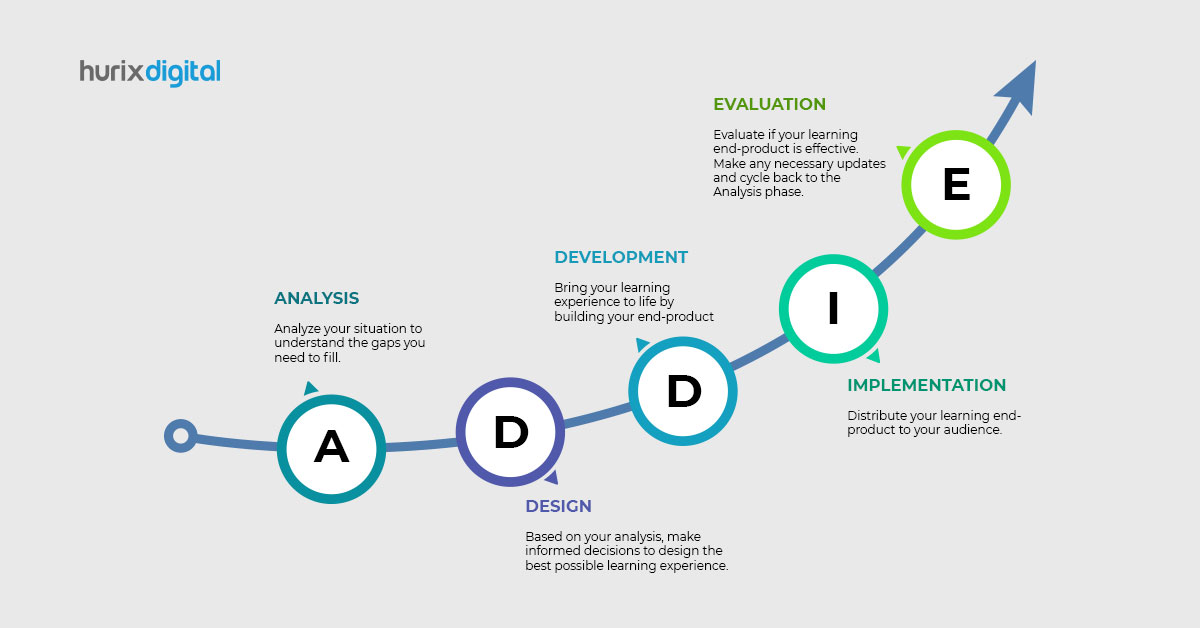
The key components of this model are-
- Analysis: The phase involved establishing the main instructional problem and overall instructional goals, followed by identifying the learner’s needs, including existing skills and knowledge.
- Design: The step involves outlining the learning objectives, instructional strategies, content, assessments, lesson planning, subject matter analysis, and media selection.
- Development: At this stage, instructional designers create and assemble content and various instructional materials.
- Implementation: This step involves developing training, including detailed instructional guides for instructors/facilitators, testing key resources and instructional materials, and considering budget and staffing needs.
- Evaluation: This final step involves finalizing both formative and summative evaluation plans.
The highlight of the ADDIE framework is that it effectively tackles eLearning development rather than just learning behaviors. It allows instructional designers to understand and dig deeper into the needs, learning objectives, and desired outcomes to create more personalized eLearning resources for Higher Education students.
2. Bloom’s Taxonomy
In Bloom’s taxonomy framework, educators classify the different skills and objectives they set for their students. Created by Benjamin Bloom in 1956, this is an excellent classification system for organizing the different levels of cognitive learning.
Unlike the earlier version, the new Bloom’s revised taxonomy aimed for a more dynamic classification idea, including testing, instruction, and assessment.
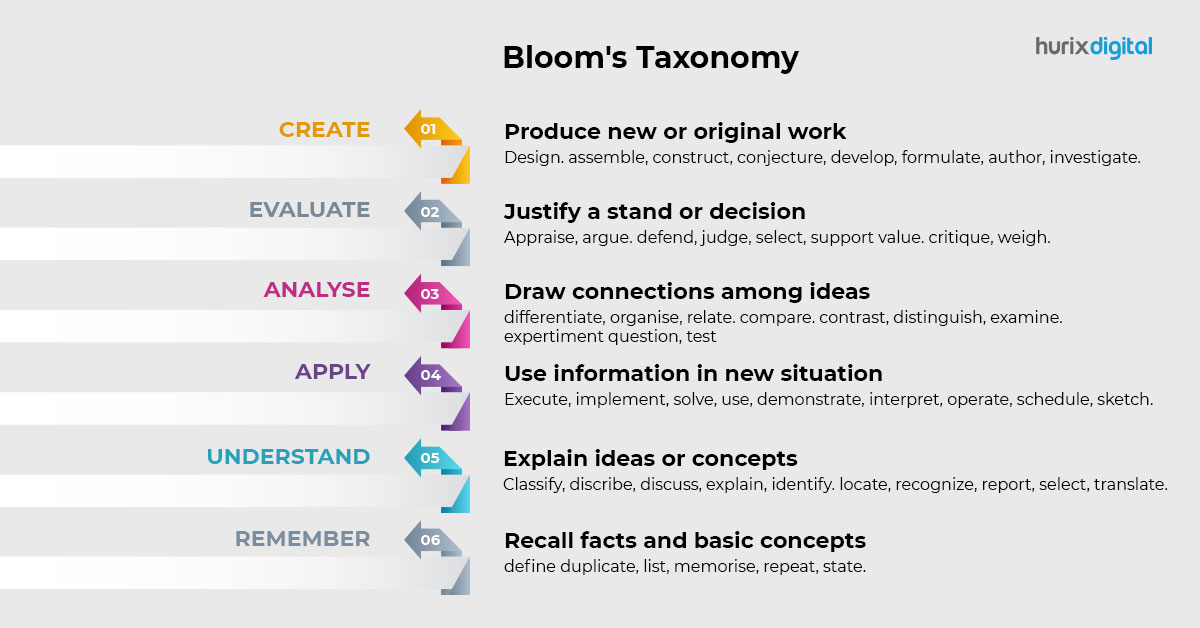
The key components of this framework are-
- Remembering: The phase involves retrieving prior knowledge from long-term memory and subsequently using the connections to aid in current understanding.
- Understanding: Involves using various strategies to conclude from current information, such as comparing meaning from messages, summarizing, and interpreting ideas.
- Applying: The phase involves implementing the procedure for learning.
- Analyzing: The step entails dividing the entire information into various meaningful parts while ensuring that all of these parts remain relevant to each other and the overall instructional goal.
- Evaluating: Involves critiquing and assessing information based on the overall outline learning criteria.
- Creating: The phase involves organizing the ideas into a new structure to develop a coherent pattern of understanding.
3. Backward Design/ Understanding By Design (UbD) Framework
This is another popular instruction-learning design framework for higher education. It is primarily based on the key ideas and research of cognitive psychology. It is mainly an iterative process that constantly promotes reflection and improvement of the curriculum.
The main aim of this framework is to offer students various productive and engaging learning experiences to facilitate their understanding while maintaining alignment with established learning standards.
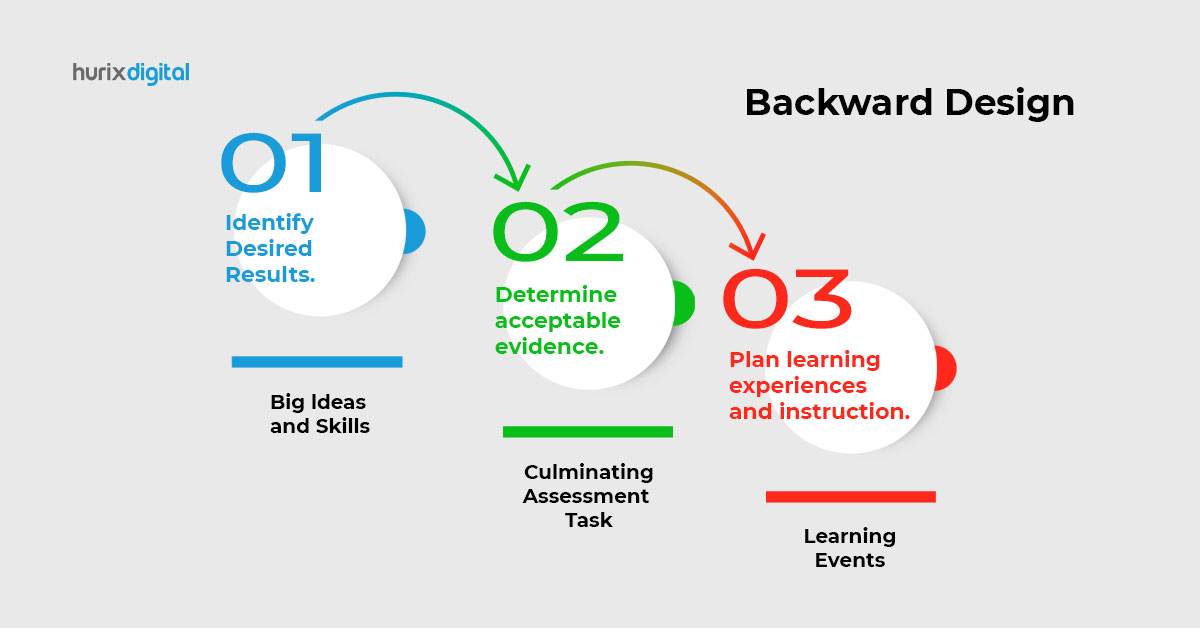
The key components of this framework are-
- Identification of Desired Results: The step involves considering long-term goals, examining established content standards, followed by reviewing curriculum expectations.
- Determination of Assessment Evidence: This step involves distinguishing between two types of assessment, including performance tasks (traditional quizzes/tests) and other evidence. Performance tasks require students to apply their learning to a new situation to assess their understanding.
- Planning of Learning Experiences and Instruction: At this step, designers are required to plan lessons and learning activities to effectively address the goals identified in the first stage.
4. Design Thinking Framework
It is a solution-based approach that involves clearly understanding and empathizing with the learner. While doing this, the designer works on the specific needs of the learner and the creative solutions that instructional design in higher education can offer as solutions.
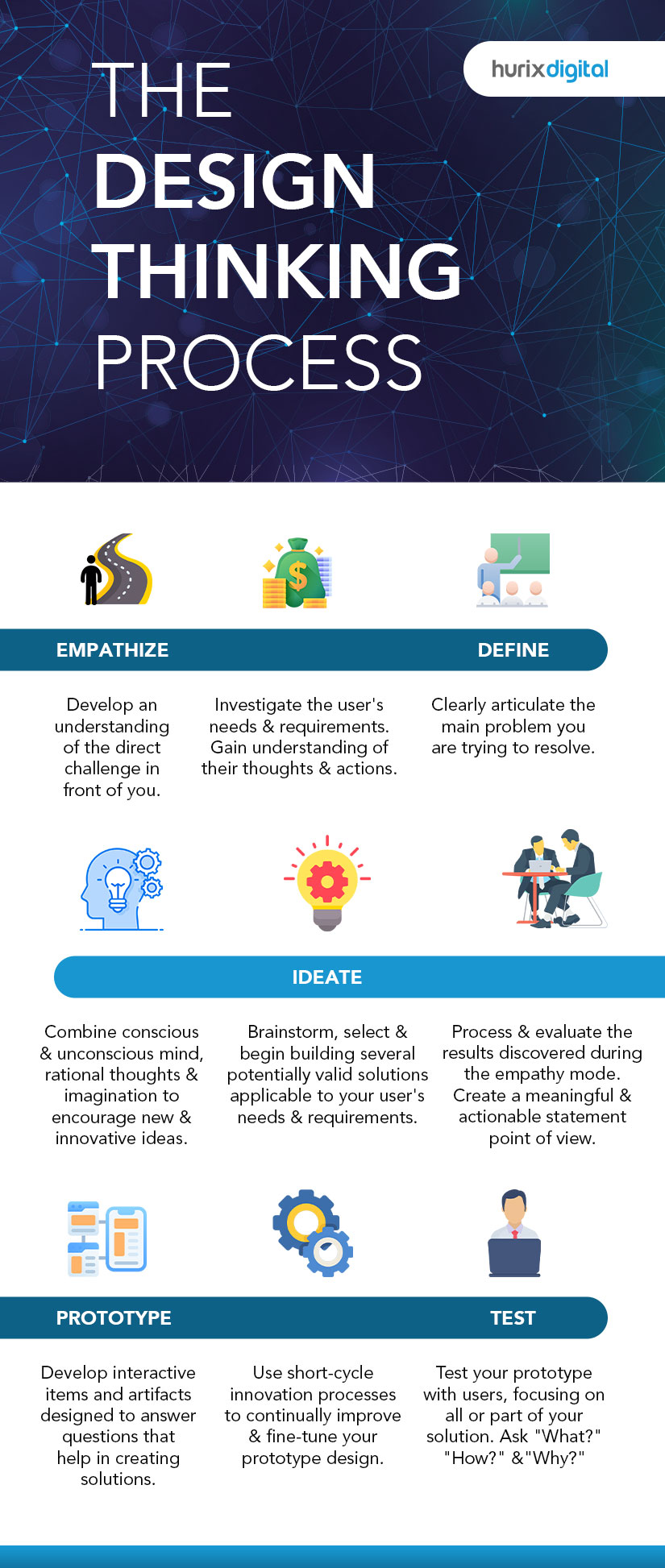
The key components of this framework include-
- Empathizing: The idea is to gain an empathetic understanding of the main problem by observing, engaging as well as empathizing with people to understand their experiences and motivations. It encourages instructional designers to part away with their assumptions to gain insight into users and their specific needs.
- Defining- Involves compiling information from the above stage to analyze and synthesize different observations to be able to define the problem.
- Ideating: Involves identifying new solutions to the problem using various techniques.
- Prototyping- Includes producing inexpensive versions of the product/features within the product to investigate the solutions, to identify the best solution for each of the problems identified in the above stages.
- Testing: Here, testing of the complete product is done using the best solutions from the prototyping phase, and iterations/ refinement continue to be made.
5. Merrill’s Principle Of Instruction
Founded by M. David Merrill, the framework has five core principles centered on task-based learning. The key premise of this framework is that effective learning experiences are rooted in problem-solving.
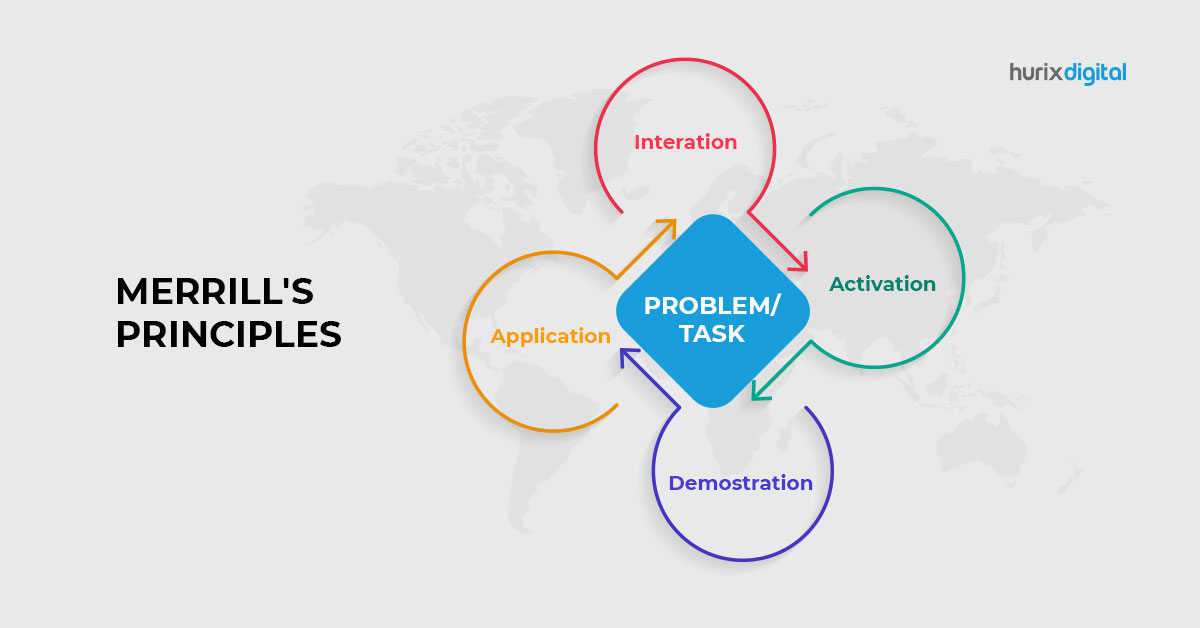
The key components of the framework include-
- Demonstrating: To apply the demonstration principle in eLearning course design, designers need to consider adding videos, online training tutorials, and other image-rich infographics that showcase the main ideas.
- Applying: Based on this model, this step comes in the form of interactive problem-solving and task performance to allow learners to see the challenges and obstacles firsthand.
- Activating: Learners must also be able to link the information to pre-existing knowledge, including past experiences that relate to the subject matter they are now exploring.
- Integrating: The phase involves exploring meaning and context where learners must get the chance to integrate their newly acquired skills or knowledge.
- Engaging: It involves task-centric learning that encourages learners to engage with the content by using everything they’ve learned to solve the problem and connecting it to real-world applications.
Also Read: How Higher Education Can Prepare Students for Emerging Careers?
To Wrap Up
Instructional learning design frameworks in higher education are often used when planning for online learning.
However, the structure they offer can also be used by educators who are planning courses that will be delivered in face-to-face or hybrid formats as well.
Here, we have discussed some of the top higher education instructional design frameworks and the types of educational frameworks that can help guide you effectively in planning your course as well as organize what you plan to teach, and how you plan to teach, along with encouraging you to evaluate your success in these areas.
If you’re exploring ways to enhance your training programs with tailored solutions, consider partnering with an experienced team.
With over 20 years of expertise in creating innovative learning materials for corporate and educational organizations, Hurix Digital offers comprehensive support to meet your instructional design needs.
We not only bring deep expertise to the table, but also collaborate closely with you to ensure the solutions align with your organization’s goals. Reach out to us to learn more about how we can assist you in achieving your training objectives.
Summarize with:

Senior Vice President – Business Development
at Hurix Digital, with over 25 years of experience in EdTech and workforce learning. He excels in business development, customer relationship management, and scaling digital learning solutions, driving global growth through innovative content, simulations, and AI‑driven training offerings
 Upcoming Masterclass | Build an Army of Brand Evangelists using Training & Development | November 20th, 8:30 AM PDT | 11:30 AM EDT | 10:00 PM IST
Upcoming Masterclass | Build an Army of Brand Evangelists using Training & Development | November 20th, 8:30 AM PDT | 11:30 AM EDT | 10:00 PM IST




